







Back to Observing Reports
October 13,
2012 at Shot Rock
NELM
7.0
7.1, then degraded to 6.8
Seeing:
3/5
improving to 4/5
Transparency:
4/5
to 3/5
Humidity
started
at 75%, then dropped to 50%. Temps
stabilized at 39-40F
Telescope:
22 f/4.0 reflector on an equatorial platform
Eyepieces: 24mm Panoptic
(finder eyepiece), 10, 6 and 4mm ZAO-IIs, 10 and 6mm
Delos, 9 and 7mm BGOs, and TMB 1.8x ED Barlow
There
were
five of us there with scopes ranging from 10 to a pair
of 22.
Quick
note
about the KTG
Catalogue as a few of the trios observed were part
of this list. It
is Part I of isolated triplets of galaxies researched by
a group of Russian astronomers in a paper published in
Astrofizicheskie Issledovaniia, vol. 11 in 1979. This
list contains 84 isolated triples of northern-hemisphere
galaxies with apparent magnitudes of the components m
< 15.7 mag. There
is a similar list for the southern hemisphere, KTS
Abstract of
the original paper
A
list of 84 northern isolated galaxy triplets with
component apparent magnitudes no fainter than 15.7 is
compiled on the basis of a complete examination of
Palomar Sky Survey prints. Equatorial coordinates,
photographic apparent magnitudes, angular diameters,
angular separations, morphological types, radial
velocities, and other characteristics of the triplet
members are provided, along with finding charts. Three
main types of triplet configuration are distinguished:
double, line, and triangle. It is shown that triple
systems constitute 0.8% of northern galaxies brighter
than 15.7 mag, that 64% of the triplets are 'completely
isolated', and that 24% of the triplet members are
elliptical and lenticular galaxies, while 76% are
spirals and irregulars.
All
object parameters are listed in RA, Dec, size and listed
magnitude without commas.
Images are from the Sloan Digital Sky Survey (color) or
the Digital Sky Survey (black and white)
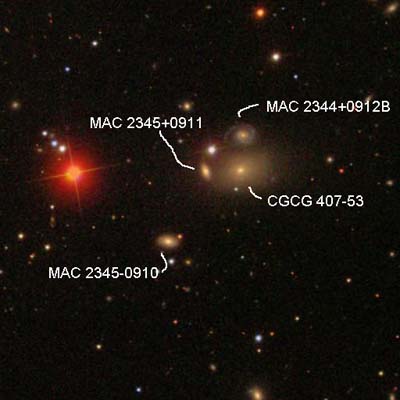 CGCG 407-53 trio in Pegasus
CGCG 407-53 trio in Pegasus
22 (328, 383 and
575x) Very compact trio of very faint galaxies
arranged in a 45 degree right triangle occupying a space
of less than 40. Think
Jupiter could cover this entire trio. This trio is
also part of Abell Galaxy Cluster 2657. A mag 13.5
star is just NE from the middle long side of the
triangle.
CGCG 407-53 (23 44
57.3 +09
11 36 0.7x0.7 15.3)
Very faint small round glow. Held with
averted vision 100% of the time. 0.2 across.
MAC 2345+0911 (23 44
59.7 +09
11 35 0.3x0.2 15.5)
Extremely faint small round glow seen with averted
vision only 50% of the time. 0.1
across and 0.6 east of CGCG 407-53
MAC
2344+0912B
(23 44 57.5
+09 12 12
0.5x0.5
16.0)
Extremely faint very small round glow that pops in and
out 25% of the time.
0.1 across and 0.6 due north of CGCG 407-53.
Nearby
galaxy,
MAC 2345+0910 (23
45 02.4 +09
10 25 0.4x0.3 15.5),
is a very faint small round glow. 0.1 across
and 1.7 SE from CGCG 407-53
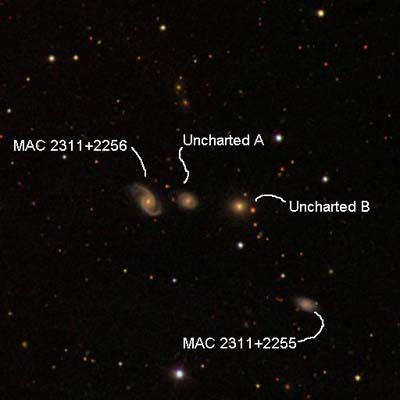 MAC 2311+2256 trio in
Pegasus
MAC 2311+2256 trio in
Pegasus
22
(328,
383 and 690x) Very compact linear trio of very faint
galaxies. Two
are uncharted in MegaStar.
The listed magnitudes were pulled using the Sloan
Navigation chart. Ive
used the g magnitude as it is the one closest to the
visual green magnitude.
MAC 2311+2256 (23 11 19.4 +22 56 49 0.7x0.3 16.5,
SDSS=16.18g)
Very faint round glow.
Seen 100% of the time with averted vision. 0.1 across.
Uncharted A (23 11 16.4 +22 56 46 0.2 SDSS=16.84g)
not seen
Uncharted B (23 11 12.5 +22 56 40 0.2 SDSS=16.96g)
extremely faint small round glow. 0.1 across
and 1.5 due west of the MAC. A faint mag
16.7 star lies 0.7 due south.
I
didnt see MAC 2311+2255.
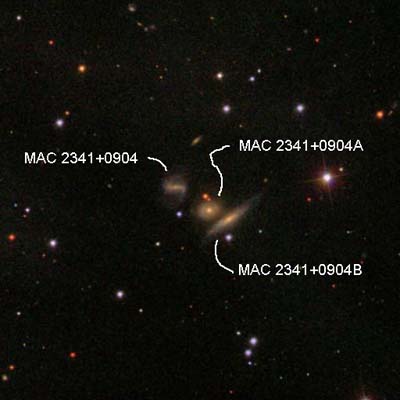 MAC 2341+0904 trio in
Pegasus
MAC 2341+0904 trio in
Pegasus
22
(328,
383 and 690x) Very compact linear trio of galaxies
arranged WNW to ESE and 1.3 long. Only one was
seen.
MAC
2341+0904B (23
41 30.9 +09
04 24 0.6x0.2 16.0,
SDSS=15.86g)
Extremely faint round glow seen only 25% of the time.
MAC
2341+0904A (23
41 32.9 +09
04 32 0.4x0.4 16.5,
SDSS=16.14g)
not seen
MAC 2341+0904 (23 41 34.6 +09 04
56 0.7x0.5 17.0,
SDSS=17.25g)
not seen.
 IC 1583 trio in Andromeda
IC 1583 trio in Andromeda
22
(328
and 383x) Crooked collinear trio of galaxies aligned
about SW to NE and about 2.7 long.
IC 1583 (00 47 10.3 +23 04 26 0.6x0.3 15.2) - Considerably
faint round glow with a much brighter center and well
defined edges. 0.2
across.
IC 1585 (00 47 14.3 +23 03 12 0.8x0.5 15.5)
- Considerably faint round glow with a much brighter
center and slightly diffuse edges. 0.2 across. Very similar
in brightness to IC 1583, which is 1.6 NW.
MCG+4-3-3 (00 47 19.4 +23 02 55 0.6x0.2 16.9)
Extremely faint 2:1 elongated glow with diffuse edges. Even surface
brightness. PA
= 70 and 0.2 long.
Lies 1.1 ESE from IC 1585.
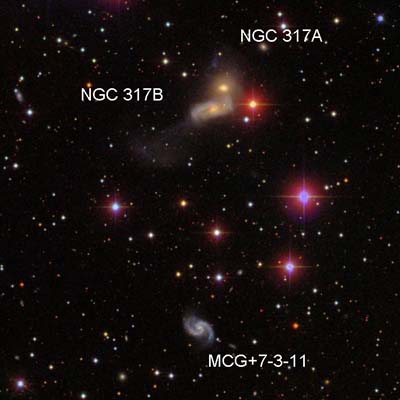 NGC 317A/B trio in
Andromeda (KTG
02)
NGC 317A/B trio in
Andromeda (KTG
02)
22
(328
and 383x) Nice trio of a double galaxy with a single
galaxy 5.4 due south in a fairly star rich region. Note: There is a
very faint plume spewing to the SE of NGC 317B which I
didnt see.
NGC 317A (00 57 39.2 +43 48 03 1.3x1.2 14.3) -
Faint round glow with defined edges. Nearly stellar
core. 0.4
across.
NGC 317B (00 57 41.0 +43 47 28 1.1x0.5 13.9)
Faint diffuse round glow, but with averted vision, it
grows to 5:2 elongated glow with a round brighter core. Diffuse edges. PA = 120 and
0.9x0.4 across. This
is almost merged with NGC 317B, which is just north. A pair of mag
11.4 and 13.7 stars lies just 0.7 east.
MCG+7-3-11 (00 57 42.3 +43 42 10 0.8x0.5 15.1b)
- Very faint diffuse round glow with diffuse edges 0.5 across. 5.4 south of
the NGC 317 pair.
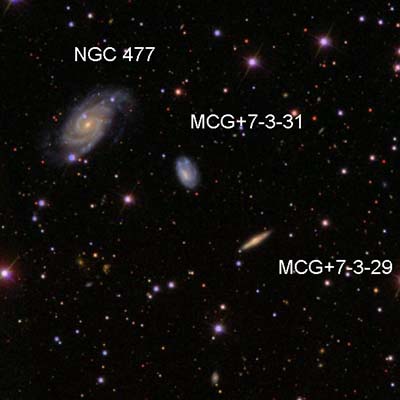 MCG+7-3-29 trio in
Andromeda
MCG+7-3-29 trio in
Andromeda
22
(328
and 383x) Almost collinear string of three galaxies
running from ENE to WSW and 4.7 long.
MCG+7-3-29 (01 21 01.3 +40 26 48 0.7x0.2 15.0)
This western most member is a faint 2:1 elongated even
surface brightness glow with diffuse edges. PA = 120 and
0.4 long. No
central brightening.
MCG+7-3-31 (01 21 09.3 +40 28 13 0.9x0.4 14.5)
The middle member is a faint slightly elongated even
surface brightness glow with diffuse edges. 0.3x0.2 and
PA = 30 degrees.
NGC 477 (01 21 20.7 +40 29 17 2.1x1.1 13.7p)
This eastern most member is a considerably bright 4:3
elongated glow with a slightly mottled appearance. Slightly
brighter stellar core.
0.9 long and PA = 135 degrees. A mag 13.5
star is just off the SE end.
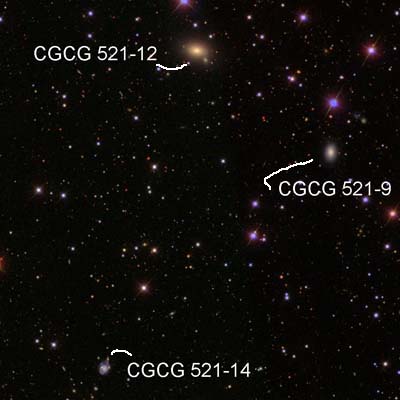 CGCG 521-9 trio in
Andromeda
CGCG 521-9 trio in
Andromeda
22
(230
and 328x) Widely spaced triangle of three small
galaxies.
CGCG 521-9 (01 22 30.6 +39 11 57 0.4x0.3 15.2)
Faint round even surface brightness glow with diffuse
edges. 0.2
across.
CGCG 521-12 (01 22 54.2 +39 15 25 0.7x0.6 14.7)
Considerably bright 4:3 elongated glow with defined
edges. Slightly
brighter center. PA
= 90 degrees and 0.3 long. 5.8 NE from
CGCG 521-9.
CGCG 521-14 (01 23 10.7 +39 04 33 0.3x0.3 15.3)
Very faint even surface brightness round glow with
diffuse edges. 0.2
across. 10.6
SE from CGCG 521-9.
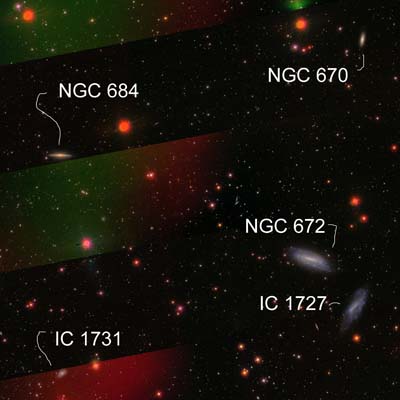 NGC 672 trio in Triangulum
NGC 672 trio in Triangulum
22
(96,
230 and 383x) Very wide group of galaxies with two
large diffuse galaxies with three easily detectable
nearby galaxies.
NGC 672 (01 47 54.3 +27 25 59 7.3x2.5 11.5b)
Bright 5:2 elongated glow with a slightly mottled thing
center along the axis.
Very diffuse edges.
PA = 75 degrees and 3.4 long.
IC 1727 (01 47 31.3 +27 19 39 6.9x3.0 12.1b)
Considerably faint 3:1 elongated glow with very diffuse
edges. Even
surface brightness.
PA = 160 and 2.7 long. 8.0 SW on NGC
672.
NGC 670 (01 47 25.0 +27 53 08 2.2x0.9 13.6b)
Considerably bright 3:1 elongated glow with well-defined
edges. PA =
0 and 0.7 long.
NGC 684 (01 50 14.1 +27 38 48 3.4x0.6 13.3b)
Considerably bright thin glow with a brighter central
bulge and a stellar core.
2.0 long and PA = 90 degrees.
IC 1731 (01 50 12.4 +27 11 45 1.5x0.9 14.0p)
Faint even surface brightness round glow with diffuse
edges. 0.7
across. A
mag 9.4 star lies 4.2 slightly north of due west.
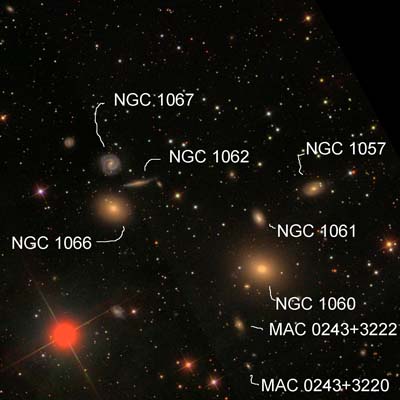 NGC 1060 trio in Triangulum
NGC 1060 trio in Triangulum
22
(230
and 383x) This is the western trio in a rich field
full of galaxies. The
other trio, NGC 1066 group, lies only 7 east.
NGC 1060 (02 43 15.1 +32 25 29 2.3x1.7 11.8v)
Very bright round glow with diffuse edges. Gradually
then suddenly brighter center. 1.3 across.
NGC 1061 (02 43 15.8 +32 27 59 1.0x0.7 15.0p)
Considerably faint 3:2 elongated even surface brightness
glow with diffuse edges.
PA = 45 and 0.4 long. 2.6 due north
of NGC 1060.
NGC 1057 (02 43 03.0 +32 29 28 1.7x0.8 15.2p)
Faint round glow with diffuse edges. Slightly
brighter center. PA
= 120 degrees and 0.8 long.
Nearby
galaxies:
MAC
02433+3222 (02
43 20.5 +32
22 47 0.9x0.5
16.5)
Extremely faint small round glow. See with
averted vision about 50% of the time. 2.9 SSW of
NGC 1060. 0.2
across.
MAC 0243+3220 (02 43 18.4 +32 20 40 0.4x0.2 16.0)
Very faint small round glow. Seen with
averted vision 75% of the time. 0.1 across
and 2.1 SSW of MAC 0243+3222.
NGC 1066 trio
in Triangulum
22
(230
and 383x) Compact trio of galaxies arranged in a 45
degree right triangle.
The long side is 2.5 long and running N-S with
the other galaxy to the west.
NGC 1066 (02 43 50.0 +32 28 30 1.8x1.5 14.3p)
Bright round glow with a brighter center. Diffuse edges. 1.0 across.
NGC 1062 (02 43 44.3 +32 29 45 1.7x0.3 15.4p) Very faint 2:1 elongated even surface brightness glow with very diffuse edges. PA = 100 and 0.6 long. 1.9 NW of NGC 1067 (02 43 50.5 +32 30 41 1.2x1.0 14.6b) Faint round glow with diffuse edges. Even surface brightness with a very small slightly brighter core. 0.7 across and 2.3 north of NGC 1066.
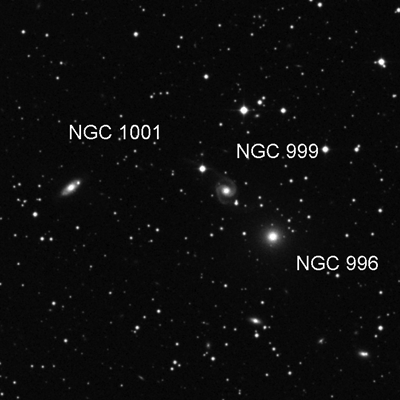 NGC 996 trio in Perseus
NGC 996 trio in Perseus
22
(230
and 383x) A group of three galaxies in a fairly star
rich area.
NGC 996 (02 38 39.6 +41 38 52 1.2x1.2 14.0p)
Considerably bright round glow with defined edges. Nearly stellar
core. 0.6
across.
NGC 999 (02 38 47.6 +41 40 14 1.2x0.8 14.4p)
Considerably bright round glow with a very faint halo. The core is
0.3 across and halo is 0.5 across. A mag 13.9
star is just off the SW edge and a mag 11.4 star is just
0.9 NE. 2.0
NE from NGC 996.
NGC 1001 (02 39 12.4 +41 40 20 1.0x0.6 14.9)
Considerably bright 3:1 elongated glow with defined
edges. Nearly
stellar core. PA
= 135 and 0.6 long.
A faint knot (or star) is on the NW tip. 4.6 due east
of NGC 999.
 IC 275 trio in Perseus
IC 275 trio in Perseus
22
(230, 383, 591 and 690x) This IC galaxy is actually a
very compact triple galaxy system arranged in a
30-60-right triangle that occupies a very small space of
35 across. This trio is resolved at 591 and 690x. Requires some
patience sitting at the eyepiece to see all three
members.
PGC 11389 (03 00 55.9 +44 21 00 0.4x0.4 17.3)
Very faint very small galaxy located at the right
angle of the triangle.
0.1 across.
PGC 11388 (03 00 55.8 +44 20 47 0.2x0.2 17.5)
Extremely faint very small round glow. <0.1
across. Sitting
at the 60 degree angle and just 15 due south of NGC
11389.
PGC 11390 (03 00 58.7 +44 20 59 0.2x0.2 17.5)
Extremely faint very small round glow. At the 30
degree angle and 35 due east of PGC 11389.
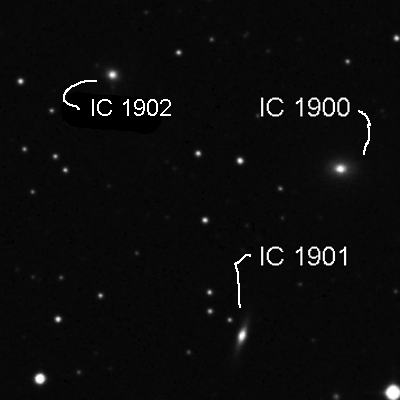 IC 1900 trio in Perseus
IC 1900 trio in Perseus
22 (230, 328 and
383x) Fairly loose trio of galaxies arranged in a
30-60-right triangle.
IC 1900 (03 15 55.1 +37 09 17 0.7x0.4 15.1)
Considerably faint 4:3 elongated even surface brightness
glow with defined edges.
Stellar core.
0.5 long and PA = 90 degrees.
IC 1901 (03 16 2.6 +37 06 45 0.8x0.3 15.7)
Faint slightly elongated even surface brightness glow
with defined edges.
Almost stellar core. 0.5 long and
PA = 165 degrees. 3.0
SSE of IC 1900.
IC 1902 (03 16 12.4 +37 10 39 0.5x0.3 15.7)
Very faint round even surface brightness glow with
diffuse edges. 0.2
across and 3.7 slightly north of east from IC 1900.
 PGC 8731 trio in Aries
PGC 8731 trio in Aries
22
(230
and 383x) Nice string of very faint very small round
glows arranged is a slightly crooked collinear row
aligned ENE to SWS.
Two other similar sized galaxies are about 3.5
east.
PGC 8731 (02 17 11.9 +27 44 00 0.3x0.3 17.1b)
Extremely faint round glow visible with averted vision
50% of the time. 0.1
across.
PGC 8734 (02 17 15.6 +27 44 53 0.5x0.4 16.7b)
Very faint small round glow visible with averted vision
75% of the time. 0.1
across and 1.2 NE of PGC 8731.
NGC 8741 (02 17 20.5 +27 45 17 0.4x0.3 17.1b)
Extremely faint small round glow visible only 33% of the
time with averted vision.
0.1 across and 1.1 ENE of PGC 8734.
Nearby
galaxies:
PGC 8745 (02 17 32.2 +27 42 12 0.4x0.3 16.8b)
Very faint small round glow visible nearly 100% of the
time with averted vision.
A mag 14.4 star lies between this and PGC 8753.
PGC 8753 (02 17 34.9 +27 43 47 0.3x0.2 17.2b)
Extremely faint small round glow visible 25% of the time
with averted vision.
1.7 NNE of PGC 8745. A mag 13.4
star lies just 20 east of it thus hindering the view a
bit.
 MCG-5-2-23 trio in Sculptor
MCG-5-2-23 trio in Sculptor
22
(230 and 383x) This trio along with the other two trio
Ive observed in Sculptur was in the soup just 25
degrees above the southern horizon. The
transparency overall has dropped a bit when I got to
this object.
MCG-5-2-23 (00 36 27.4 -27 45 05 1.1x0.4 14.6p)
Considerably faint slightly elongated glow with
defined edges. Slightly
brighter center. 0.5
long and PA = 100 degrees.
MCG-5-2-24 (00 36 37.5 -27 47 18 0.8x0.5 15.1p)
Very faint small round glow with defined edges. 0.5 across
and 2.5 east of MCG-5-2-23
MCG-5-2-26 (00 36 42.5 -27 49 06 1.2x0.1 16.2)
Extremely faint small glow detected only 25% of the
time with averted vision.
2.1 SE from MCG-5-2-24.
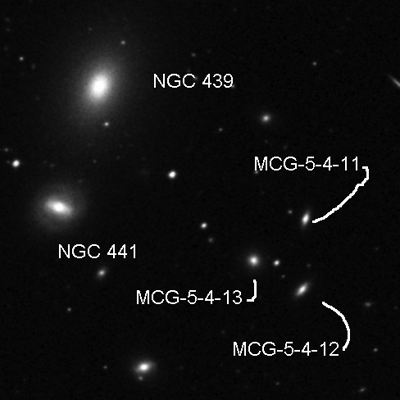 MCG-5-4-12 trio in Sculptor
MCG-5-4-12 trio in Sculptor
22
(230, 328 and 383x) A compact equilateral triangle of
very faint small round glows with each side about 1.6
long. A
bright pair of galaxies, NGC 439 and 441, about 4 east
MCG-5-4-12 (01 13 27-7 -31 49 02 0.5x0.3 16.0b)
Southern end and 0.1 across.
MCG-5-4-11 (01 13 27.4 +31 47 35 0.4x0.2 16.3)
Northern end and 0.1 across.
MCG-5-4-13 (01 13 32.4 -31 48 28 0.4x0.4 15.9b)
eastern end and 0.1 across.
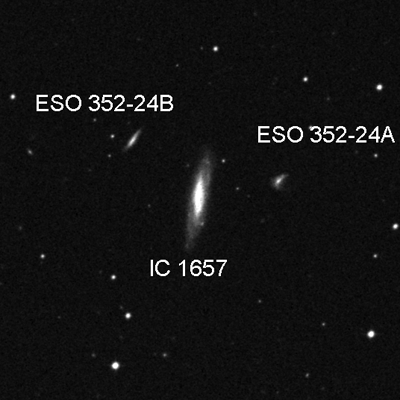 IC 1657 trio in Sculptor
IC 1657 trio in Sculptor
22
(230
and 383x) A bright thin galaxy with a small companion
on each side.
IC 1657 (01 14 07.1 -32 39 08 2.3x0.5 13.1p)
Considerably bright 5:1 elongated glow with a slightly
brighter thin center.
PA = 0 and 1.5 long.
ESO 352-24B (01 14 13.8 -32 37 45 0.7x0.2 16.3)
Extremely faint small glow with diffuse edges. 2 NE of IC
1657. See
about 25% of the time.
ESO 352-24A 01 13 58.7 -32 38 48 0.6x0.3 15.3)
Very faint small round glow with diffuse edges. 1.7 slightly
north of west from IC 1657.
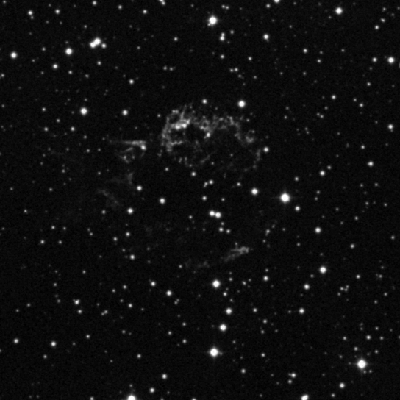 Cassiopeia A (23 23 24.0 +58 48 54)
Cassiopeia A (23 23 24.0 +58 48 54)
22
(96
and 230x) While taking a break from the trios and
waiting for the three trios in Sculptor to cumulate,
Ive decided to take a quick look at this supernova
remnant for a couple minutes, so I didnt look for any
detail.
Easily
seen
without filters. Used
the Astronomic NPB, Lumicon O-III and Orion Ultrablock
(the original one made in Japan in the 90s) and best
seen with the Lumicon O-III.
Back to Observing Reports
All Observing Reports are copyrighted by Alvin Huey. You can print them for personal use only.
Components Aids Guides Observing Guides Reports
